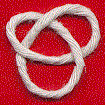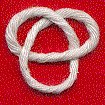

Left and right-handed trefoils.

Knots and their polynomials


Topologists consider two knots to be the same if one can be deformed to match the other. The statement ``Left and right-handed trefoil are different'' means to a topologist that no matter how the string is stretched or twisted in three-dimensional space, there is no way to change one into the other without tearing the string.
How do you prove mathematically that something can't be done? The usual way in topology is to figure out some quantity that can be calculated from a configuration, and such that when the configuration is changed following the rules (here: without tearing the string) that quantity does not change. Such a quantity is called an invariant. If you can find an invariant which gives different values for the left and right-hand trefoil, that will prove that one cannot be deformed to the other.
Back to the first knot page.